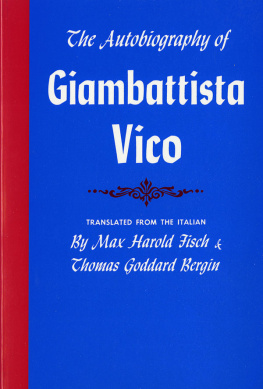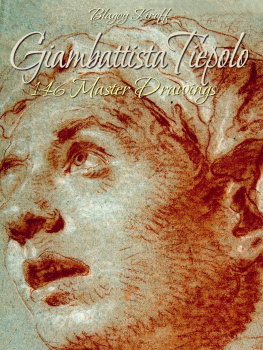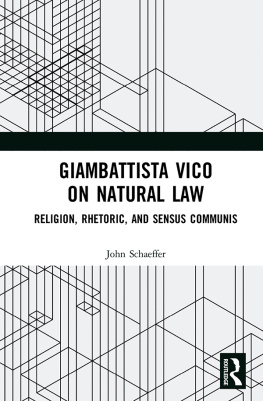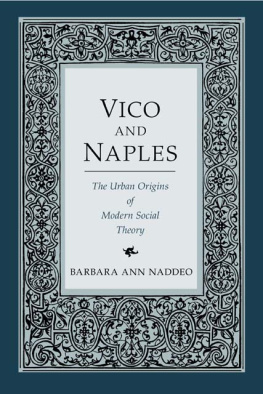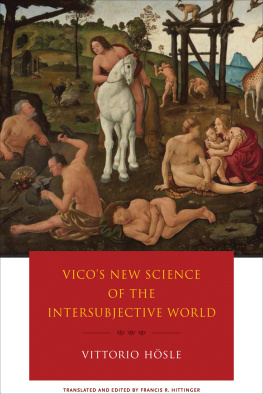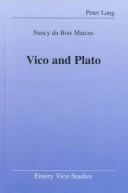Vico Giambattista - The Autobiography of Giambattista Vico
Here you can read online Vico Giambattista - The Autobiography of Giambattista Vico full text of the book (entire story) in english for free. Download pdf and epub, get meaning, cover and reviews about this ebook. year: 2015, publisher: Lightning Source Inc. (Tier 3), genre: Science. Description of the work, (preface) as well as reviews are available. Best literature library LitArk.com created for fans of good reading and offers a wide selection of genres:
Romance novel
Science fiction
Adventure
Detective
Science
History
Home and family
Prose
Art
Politics
Computer
Non-fiction
Religion
Business
Children
Humor
Choose a favorite category and find really read worthwhile books. Enjoy immersion in the world of imagination, feel the emotions of the characters or learn something new for yourself, make an fascinating discovery.
- Book:The Autobiography of Giambattista Vico
- Author:
- Publisher:Lightning Source Inc. (Tier 3)
- Genre:
- Year:2015
- Rating:5 / 5
- Favourites:Add to favourites
- Your mark:
- 100
- 1
- 2
- 3
- 4
- 5
The Autobiography of Giambattista Vico: summary, description and annotation
We offer to read an annotation, description, summary or preface (depends on what the author of the book "The Autobiography of Giambattista Vico" wrote himself). If you haven't found the necessary information about the book — write in the comments, we will try to find it.
The Autobiography of Giambattista Vico — read online for free the complete book (whole text) full work
Below is the text of the book, divided by pages. System saving the place of the last page read, allows you to conveniently read the book "The Autobiography of Giambattista Vico" online for free, without having to search again every time where you left off. Put a bookmark, and you can go to the page where you finished reading at any time.
Font size:
Interval:
Bookmark:


GIAMBATTISTA VICO
(See Note 212)
V ICO has long been regarded as the greatest of Italian philosophers. Two centuries have passed since his death and the definitive edition of his major work, the Scienza nuova . Only small parts of that work, and a few passages quoted from his other writings, have so far appeared in English translation.
The first complete English version of any of his writings is that here offered of his autobiography, with which students of his thought have generally found it advisable to begin. Aside from the light it sheds on his other works, and the interest it has in common with every other intellectual autobiography, Vicos has the unique interest of being the first application of the genetic method by an original thinker to his own writings.
Vicos Italian bristles with difficulties even for Italians, and it is not likely that we have resolved them all. To preserve something of the flavor of the original, we have translated literally wherever a literal rendering seemed readily intelligible; but we have broken up most of his longer periods, and have resorted to paraphrase and bracketed insertions wherever we saw no other way to achieve clarity.
The text we have followed is that of the Laterza edition of Vicos works, Volume V, Bari, 1929, edited by Croce and Nicolini; and many of the notes to our translation have been adapted from those in that edition, to which the reader is referred for further details.
The translation is a work of collaboration. For the introduction, notes and chronological table I alone am responsible. In Major Bergins absence overseas, the book has gone to press without the benefit of his proofreading.
G. H. Sabine made helpful comments on an early draft of the introduction. James Hutton shed light on some difficult passages in the translation. Giuseppe Cherubini listened to a reading of the translation with the original in hand and improved the rendering at several points.
If the introduction seems disproportionately long, that is because it is intended to serve also for the translation of the Scienza nuova which we hope shortly to publish.
M. H. F.
April 1944
For the second printing a few slight changes have been made in the introduction, and the translation has been extensively revised, with the help of Elio Gianturco and other friendly critics. To section IV E of the introduction there should now be added a reference to the penetrating, though admittedly one-sided, interpretation of Vico in Laurence Stapletons Justice and World Society .
M. H. F.
September 1944
For the Great Seal Rooks printing, a few further corrections have been made in the introduction and translation, and some supplementary notes have been added on pages 222222B.
M. H. F.
T. G. B.
June 1962
I N 1728 there appeared at Venice a pocket-size book of about five hundred pages, announcing itself as volume one of a quarterly Raccolta d Opusculi Scientifici e Filologici . It proposed to include articles in theology, ethics, sacred and profane history, erudition, mathematics, physics, and even poetry, but only if the compositions be original and distinguished, so that our readers will perhaps encounter few contributions in this field.
Its editor was a young Camaldolite monk, Don Angelo Caloger; its patroness was the Duchess of Parma and Piacenza, Countess Palatine, sister of the late Empress Eleanor, and mother of the Queen of Spain. Caloger owed her patronage, and several of the articles in this first volume, to the kind offices of Count Antonio Vallisnieri, Professor of Medicine at Padua and member of the Royal Society of London.
The volume opens with a letter to Vallisnieri from a physician of Rome, describing a birth of vipers through the mouth of their mother; a long and learned reply by Vallisnieri showing that this is anatomically possible and under what conditions it may occur; and an appendix rejecting the suggestion of William Derham that this was no birth, but that the frightened mother had taken her offspring into her mouth and then released them when the danger was past. There follows a description, introduced by Vallisnieri, of a planisferologium invented and executed for the Duchess by one Bernardo Facino. This is a little machine employing numerous inventions to represent, on a vertical plane thirteen inches in diameter, all that goes on from moment to moment within the primum mobile the courses of the brightest stars of the firmament, the sun, the moon, its epicycle and dragons head; that is to say, the essentials of astronomy according to the most accurate ephemerides. And in the latter part of the volume there is a history of the city of Prato, a life of the sixteenth-century historian Gualdo, a review of a recent edition of the Decameron , and a defense of the promiscuous use of your excellency and you.
Between these two groups of articles there is A Proposal to the Scholars of Italy to write their autobiographies for the edification of young students and with a view to the reform of school curricula and methods. This proposal, animated by a desire for the advancement of learning in Italy our illustrious fatherland, is followed by much the longest article in the volume, the autobiography of Giambattista Vico, which is offered as a model. The prospective contributor is asked to relate the time and place of his birth, his parentage, and all the episodes of his life which make it remarkable or curious, so far as they can without shame be published to the world and to posterity. He is asked to weave into his narrative an exact and detailed account of all his studies. Beginning with grammar, let him say how it was taught him, whether by the methods in common use, or by some novel one; if the latter, whether it merits approval or not, and why. Proceeding thus from art to art, from science to science, let him point out the abuses and prejudices of schools and teachers, or praise their orderly curricula and sound methods, as the case may be. Let him say not only what is well and what is ill taught in the schools, but what is not taught that should be. Let him then pass on to the particular art or science to which he has devoted himself; the authors he has followed or shunned, and why; the works he has published or is preparing; how they have been criticized, what he has said or might say in defense of them, and what he would now retract. Let him candidly confess his errors, and defend only what seems defensible after due consideration, with generous neutrality.
Finally, it is emphasized that the proposal is addressed only to creative scholars. Those who have published nothing but sonnets or the like slender poems, or legal books, or treatises on moral theology, or other things of that sort, will find no place among our men of letters.
About two hundred years later the members of the American Philosophical Association, by a referendum vote, chose certain of their number to write brief intellectual autobiographies, which were published in two volumes in 1930 under the title Contemporary American Philosophy: Personal Statements . Each contributor was asked to state his principal philosophic beliefs, the reasons supporting them, and the manner in which he had reached them. It was hoped that the publication of these philosophic autobiographies would serve the purpose of clarifying the minds of the writers and of helping their students to a better understanding of their specific doctrines. This venture was inspired by a similar one in England, and that in turn by a much more ambitious German series going back to 1920: Die Philosophie der Gegenwart in Selbstdarstellungen , whose editor took as his motto Fichtes saying that the kind of philosophy a man chooses depends upon the kind of man he is. In the same decade there were similar collections for various sciences and professions, and the practice became so familiar that it is difficult now to realize the novelty of the Venetian proposal in its own time, or to do justice to the features that distinguish it from any later venture of the same general kind. The novelty is apparent from the fact that autobiography as a literary form was as yet without a name, and the model was called simply Life of Giambattista Vico written by himself. The distinctive features of the project were these: (a) its primarily pedagogical intent; (b) the representation of all the arts and sciences; (c) a uniform plan for all the autobiographies; and (d) a comprehensive critical supplement to the entire collection.
Next pageFont size:
Interval:
Bookmark:
Similar books «The Autobiography of Giambattista Vico»
Look at similar books to The Autobiography of Giambattista Vico. We have selected literature similar in name and meaning in the hope of providing readers with more options to find new, interesting, not yet read works.
Discussion, reviews of the book The Autobiography of Giambattista Vico and just readers' own opinions. Leave your comments, write what you think about the work, its meaning or the main characters. Specify what exactly you liked and what you didn't like, and why you think so.

